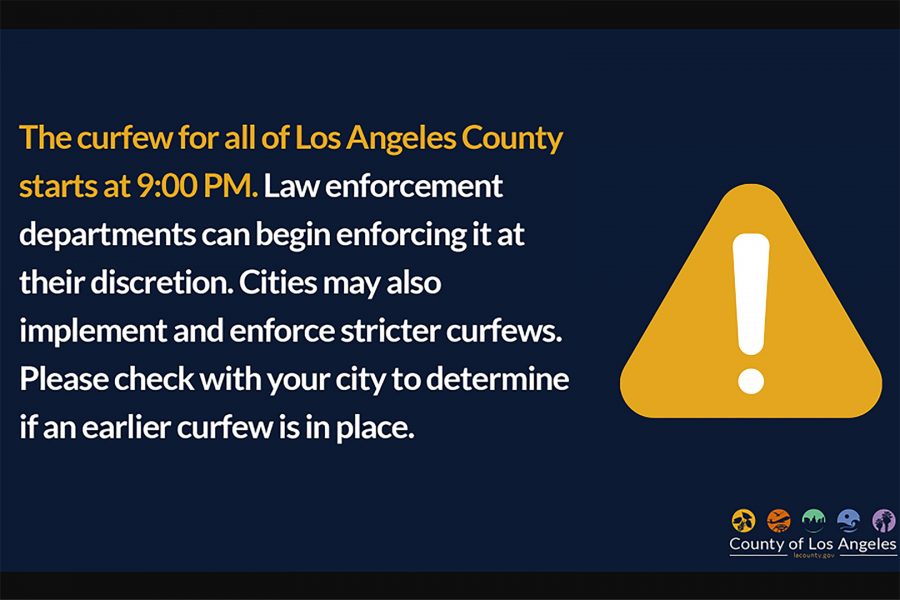In the days following the death of George Floyd, an unarmed black man killed by a police officer in Minneapolis, Minnesota, demonstrations have erupted across the country, protesting police brutality and standing in solidarity with the Black Lives Matter movement. Many elected officials have made efforts to control protests by imposing curfews, including in cities such as Los Angeles, Minneapolis, Philadelphia and New York, where demonstrations have been particularly dense and widespread.
Essential workers are technically exempt from the curfews, but they have been affected nonetheless. Many of the dozens of curfews have been announced last-minute, leaving workers with little time to prepare and forcing them to travel through militarized streets to get to and from their jobs.
“I work for a small family-owned restaurant in West Covina and on Sunday, I got the emergency notification on my phone saying that the curfew was at 6 p.m., I just arrived at work a few minutes before I received that notification,” Matthew Diaz, 23, said.
“I was a little upset that it was so sudden because I am trying to save money and I could’ve saved the gas I used to travel back and forth from work that day,” Diaz added.
Lux Montes, 25, shared that there was a lack of certainty regarding the announcement and their boss did not know about the curfew enforcement.
“I was scrolling on Instagram before my shift and saw an update from the official city of Ontario account announcing a 6 p.m. curfew,” Montes said.
“When I called my work to ask how this would affect my closing shift, one of my store owners told me they didn’t know of a curfew and had called Ontario PD at 8 a.m. to verify,” Montes added.
Indeed, there is confusion surrounding curfew enforcement; how are police to tell, upon a quick glance, who is and isn’t exempt from the rule? Essential workers, some of them undocumented, are also at higher risk for COVID-19 due to the nature of their jobs.
Curfews, as typically enforced, increase the number of police officers in the streets, which can lead to an escalation of violence. According to a Washington Post article, California Gov. Gavin Newsom deployed 1,000 members of the National Guard to assist the 20,000 officers of the Los Angeles police and sheriff’s departments.
“While I understand the potential benefits of a curfew, this is neither the right moment nor the right process for imposing one and adding an additional 4,000 officers to our streets,” Public Advocate Jumaane Williams said in a tweet. “At this moment and in this way it could escalate tension, not alleviate them.”
The efficacy of curfews in curbing social unrest is unclear, and many activists feel it’s a strategy for increasing policing while cloaked in the language of safety. “What we know is [that] curfews increase opportunities for police interaction and police violence over time,” Andrea Ritchie, a criminal justice researcher at the Barnard Center for Research on Women, told Vox.
According to the L.A. County website, “The effects of public calamity caused disaster and extreme peril to the safety of people and property. Because of the dangers which often occur under cover of darkness and the difficulty to preserve public safety during these hours, a curfew was ordered, as allowed by Government Code Section 8634.”
Under curfew, residents are required to remain in their homes and stay off public streets and areas. L.A. County listed the following exemptions from the curfew: “Peace officers, fire fighters and National Guard or other military personnel deployed to the area, individuals traveling to and from work, people experiencing homelessness and without access to a viable shelter and individuals seeking medical treatment.”
The last-minute curfews for counties left businesses confused and blindsided, unable to get their workers home in time or to properly anticipate surges or drops in business.
“My store owner called me after seeing the curfew on Ontario’s official website, which stressed that businesses should close before 6. They originally planned on closing at 6, and ended up closing at 5,” Montes said.
Anny Reyes, 34, a manager for a restaurant in Pomona, shared her sentiments regarding the situation. “We are having a tough time right now and I’m not even sure if I will still have a job tomorrow or next week,” Reyes said.
“The staff, including myself, lost money coming into work and then not working the full shift,” Reyes added. “It affects everyone and to have the curfew does not help, especially if they don’t announce it early in the day.”
As of June 4, Mayor Eric Garcetti has lifted the curfew for the City of Los Angeles.
“We remain strongly committed to protecting the right of Angelenos to make their voices heard and ensuring the safety of our community,” Garcetti stated in a tweet.
For more information, visit lacounty.gov/emergency for the most up-to-date curfew schedule for Los Angeles County.



